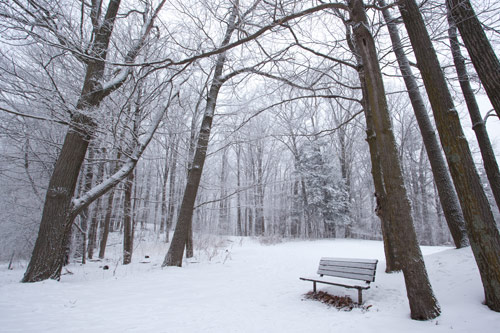When I start to get overwhelmed and anxious, I have found that stepping out of my overscheduled life for a “haiku walk” can rewire my day. Traditionally, Japanese haiku walks are called gingkos, named after the tree, and are held in a place of historical or cultural significance or in an area of natural beauty. I live in Moscow, Russia, and often choose a place that is both visually and historically rich: Patriarch’s Pond, a park in the old center of the city. It is good to create a structure for the walk, and I do it in three parts, much like the haiku poem itself, which consists of a five-syllable line, a seven-syllable line, then five again. I warm up before I embark on my walk by letting go of my concerns—the bills that need to be paid or the work that had to be done yesterday. Then I breathe, let go, and bring my mind to a place of calm, ready to observe and be part of the moment unfolding before me. The haikus come out of this moment. I gaze out my window, breathe a few long, cleansing breaths, and start writing.
On snowy branches a lone bird is gazing in at me gazing out…
Traditional haikus are often said in one breath and usually contain a seasonal feeling or word. They also evoke a sense of Wabi (humility) and Sabi (imperfection and impermanence), and the poet is not seen as separate from the moment unfolding. There is usually a place where the poem pivots, where the moment changes. Not all haiku will reach this level of aesthetic, but I strive for it as I create my imperfect poems. After my warmup, I am in a quieter mental space, ready for the second part of the experience, which is the walk itself. I notice things on the way from my apartment to Patriarch’s Pond. The statue of the poet Vladimir Mayakovsky, for example:
The snow is falling on poet Mayakovsky— Pigeon on his head!
I reach the park and am moved by its tranquillity. I walk in a circle around the frozen pond and think of monks walking a labyrinth. I let myself engage the flashes of sunlight that shine through the clouds and dapple the trees’ bare branches. Grandmothers push babies in strollers. A dog walks on the icy pond. The faraway sound of traffic is ever present. When thoughts about my day-to-day life arise—bills, obligations—I breathe and let them go. I embrace the haiku moment and jot words down as I walk:
Look at those bird’s tracks in the newly fallen snow. But where is the bird?
I can feel my body relax. It’s as if my cells rewire themselves as I exhale the toxins of anxiety and inhale calm along with the fresh, cold air. I sit on a bench to write down poems. Some come to me in the entire three-line form; others in a line with an uncertain beginning or end; and a few are just words, ideas, or fragments of ideas. I know I can work on these later. Sometimes on my walks, I take long breaks to sit and write and then walk some more. But other times, I linger only for a few minutes:
Too cold to sit here writing haiku on this bench— I go get coffee!
This brings me to the third part of my haiku walk: the winding down. I have found it is good to give myself this transition and not re-enter the rest of my day too quickly. Often, I choose my favorite café near the park for the winding down of the gingko. I take time to sit and enjoy the warmth from the coffee, the taste of my pastry, and then I read my notes from the walk. I write a last haiku as a way to end this gingko, rewired and ready for any challenge the day can bring.
Burnt sugar coffee and a blackberry cupcake sweeten everything!
Find Out More
- Seeds from a Birch Tree: Writing Haiku and the Spiritual Journey by Clark Strand
- The Essential Haiku: Versions of Bashō, Buson, & Issa, by Robert Haas
- The Haiku Handbook: How to Write, Teach, and Appreciate Haiku, by William J. Higginson
Post Disclaimer
This content is for informational purposes only and does not constitute medical advice. Please consult a healthcare professional for any medical concerns.




14 Comments
claudia butler
Beautifully written, Resa.
Rose Caiola-Musacchia
Thank you, Claudia. I’m glad you’re enjoying the site.
Andrey Kolybelnikov
What a blessing. By reading it I got into this state. It came to me at the right moment and helped me to accept myself and the situation I’m in without wanting to change a thing… Thank you, Resa.
Rose Caiola-Musacchia
Thank you, Andrey!
Myotai
Tasting that coffee now…there is nothing better than a meander with Resa. The world becomes lighter. Bows, my friend.
Rose Caiola-Musacchia
I’m glad you’re enjoying the site. Thank you!
Urda
Your article was quite a read. I have done those walks without knowing they were Haiku walks. I got a small story out of them and called them snapshots. They are like a photo. A moment in life made to last in a tiny story.- Thank you for the read. I’ll go more purposeful on my walks now!